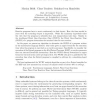3653 search results - page 111 / 731 » On Recognizable Timed Languages |
103
click to vote
CGO
2011
IEEE
14 years 1 months ago
2011
IEEE
—Approximating ideal program outputs is a common technique for solving computationally difficult problems, for adhering to processing or timing constraints, and for performance ...
AOSD
2007
ACM
15 years 2 months ago
2007
ACM
Most current software systems contain undocumented high-level ideas implemented across multiple files and modules. When developers perform program maintenance tasks, they often wa...
WEBDB
2005
Springer
15 years 3 months ago
2005
Springer
Nonrecursive XQuery is known to be hard for nondeterministic exponential time. Thus it is commonly believed that any algorithm for evaluating XQuery has to require exponential amo...
ENTCS
2008
14 years 10 months ago
2008
Reactive programs have to react continuously to their inputs. Here the time needed to react with the according output is important. While the synchrony hypothesis takes the view t...
WWW
2002
ACM
15 years 10 months ago
2002
ACM
Multimedia scheduling models provide a rich variety of tools for managing the synchronization of media like video and audio, but generally have an inflexible model for time itself...

